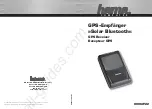
BATTERY WARNINGS AND USAGE GUIDELINES
WARNING: Lithium Polymer (LiPo) batteries are significantly
more volatile than alkaline, NiCd or NiMH batteries. All
instructions and warnings must be followed exactly to
prevent property damage and/or serious injury as the
mishandling of LiPo batteries can result in fire. By handling,
charging or using the included LiPo battery you assume all
risks associated with LiPo batteries. If you do not agree with
these conditions please return the complete product in new,
unused condition to the place of purchase immediately.
• You must always charge the LiPo battery in a safe,
well-ventilated area away from flammable materials.
• Never charge the LiPo battery unattended at any time.
When charging the battery you must always remain in
constant observation to monitor the charging process and
react immediately to any potential problems that may occur.
• After flying/discharging the LiPo battery you must allow it
to cool to ambient/room temperature before recharging.
•To charge the LiPo battery you must use a suitable compat-
ible LiPo battery charger. Failure to do so may result in a fire
causing property damage and/or serious injury.
• Store the LiPo battery at room temperature and in a dry
area for best results.
• When charging, transporting or temporarily storing the
LiPo battery the temperature range should be from approxi-
mately 40–120° F (5–49°C). Do not store the battery or
aircraft in a hot garage, car or direct sunlight. If stored in a
hot garage or car the battery can be damaged or even catch fire.
• Never leave batteries, chargers and power supplies
unattended during use.
• Never attempt to charge low voltage, ballooned/swollen,
damaged or wet batteries.
• Never allow children under 14 years of age to charge
batteries.
• Never drop batteries, chargers or power supplies.
• Always inspect the battery, charger and power supply
before charging.
• Always ensure correct polarity before connecting batteries,
chargers and power supplies.
• Always disconnect the battery after charging.
• Always terminate all processes if the battery, charger or
power supply malfunctions.
IMPORTANT NOTE: It’s safer and better for the longevity of
the battery to store it only partially charged for any length
of time. Storing the battery approximately 50% charged is
typically best, be sure not to store the battery fully charged
whenever possible. In fact, as long as the battery will be
stored at approximately room
temperature and for no more than a few weeks before the
next use, it may be best to store the battery in the
discharged state after the last flight (as long as the battery
was not over-discharged on the last flight).






































